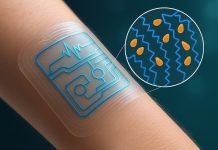
Researchers at Stanford University have developed an innovative, multilayered material with nerve-like electronics, which behaves like human skin.
This could potentially revolutionize prosthetics and wearable medical devices.
Just like our skin, this artificial electronic skin or “e-skin” can sense pressure, temperature, strain, and more.
It can feel the flutter of a butterfly, distinguish between a fist and a peace sign, sense heat or coolness, and even feel a pulse – all features that human skin naturally possesses.
The ultimate goal of this project is to create an e-skin that could directly communicate with the brain, a feat never achieved before.
Up until now, engineers faced the challenge of converting sensed signals into electrical pulses understandable by the brain, a process which required rigid electronics.
However, Stanford researchers have designed soft integrated circuits that can convert these sensed inputs into nerve-like electrical signals that the brain can interpret.
This innovation could pave the way for amputees to control prosthetic limbs using signals sent to implanted wireless communication chips in their peripheral nerves. Another potential application could be the development of innovative implantable or wearable medical devices.
“The challenge wasn’t so much about imitating human touch, but about incorporating these mechanisms into a skin-like material,” stated Zhenan Bao, a senior author of the study.
One of the main hurdles, according to Weichen Wang, a doctoral candidate in Bao’s lab, was to develop skin-like electronic materials that could generate nerve-like pulses and operate at low enough voltages to be safe for human use.
The aim was to design a soft integrated circuit that could replicate the sensory receptors’ functions while operating efficiently at low voltage. Wang’s early prototypes required more than 30 volts and were unable to deliver adequate circuit functionality. However, the new e-skin can operate on just 5 volts and can sense stimuli in a manner similar to real skin.
E-skins are vital for advanced prosthetic limbs, offering sensory feedback that aids users in controlling their prosthetics with precision. Moreover, the e-skin needs to stretch and revert without failing, while maintaining its nerve-like electrical characteristics.
The researchers created a three-layer dielectric structure that boosted the mobility of electrical charge carriers by 30 times compared to a single-layer, enabling the circuits to function at low voltage. Interestingly, one layer of this structure uses nitrile, the same rubber found in surgical gloves.
The majority of the e-skin consists of layers of skin-like materials with integrated networks of organic nanostructures. These networks can transmit electrical signals even when stretched and can be engineered to detect pressure, temperature, strain, and chemicals.
The various sensory layers are then fused together into a single, sturdy material that won’t tear or lose its electrical function. Each electronic layer is incredibly thin, with the completed e-skin being about as thick as a sheet of paper.
This invention marks a significant milestone in combining sensing capabilities and the electrical and mechanical properties of human skin into a soft, durable material. This could be used in next-generation prosthetic skins and cutting-edge human-machine interfaces, providing a human-like sense of touch.
Having developed their prototype, Bao, Wang, and their team are now focusing on enhancing the complexity and scalability of their technology. They plan to incorporate wireless functionality and explore ways to interface with the brain and the body’s peripheral parts.
Source: Stanford.



